Analyzing Fast Food Consumption Habits of SPUQC College Students
VerifiedAdded on 2020/09/09
|21
|5080
|48
Project
AI Summary
This project investigates the factors influencing fast food dependence among college students at St. Paul University Quezon City (SPUQC). The research, conducted between November 2014 and October 2015, aims to determine the demographic profile of respondents (age, gender, and weekly allowance) and identify factors such as accessibility, food quality, affordability, service time, and ambiance that affect their fast food preferences. The study utilizes survey questionnaires, validated by faculty members, to gather data on these factors, health risks associated with fast food consumption, and students' willingness to change their eating habits. The research employs a descriptive research design, analyzing data through frequency, percentage, and weighted mean calculations. The findings are intended to benefit future researchers, fast food operators, and health-conscious individuals by providing insights into student eating behaviors and the implications of fast food consumption.
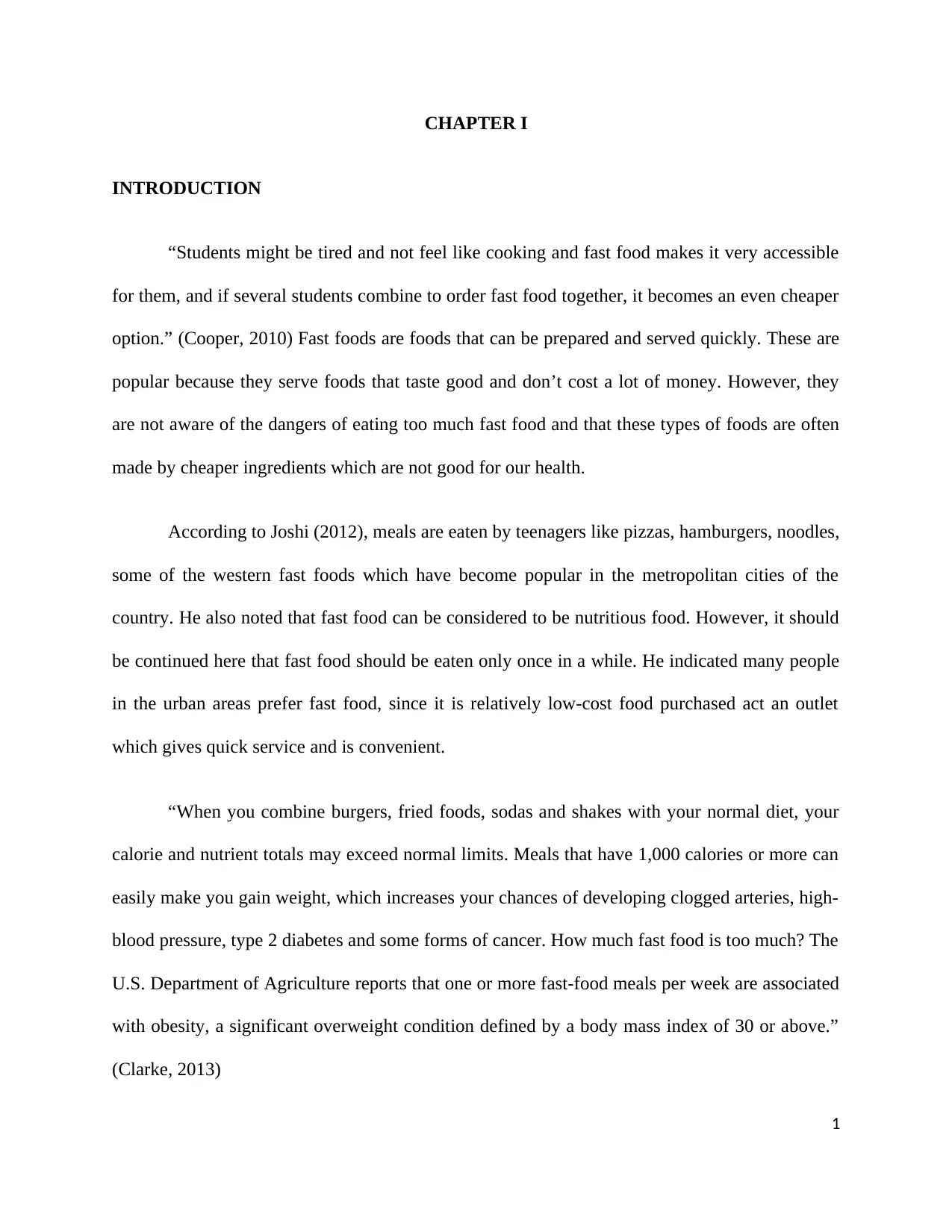
CHAPTER I
INTRODUCTION
“Students might be tired and not feel like cooking and fast food makes it very accessible
for them, and if several students combine to order fast food together, it becomes an even cheaper
option.” (Cooper, 2010) Fast foods are foods that can be prepared and served quickly. These are
popular because they serve foods that taste good and don’t cost a lot of money. However, they
are not aware of the dangers of eating too much fast food and that these types of foods are often
made by cheaper ingredients which are not good for our health.
According to Joshi (2012), meals are eaten by teenagers like pizzas, hamburgers, noodles,
some of the western fast foods which have become popular in the metropolitan cities of the
country. He also noted that fast food can be considered to be nutritious food. However, it should
be continued here that fast food should be eaten only once in a while. He indicated many people
in the urban areas prefer fast food, since it is relatively low-cost food purchased act an outlet
which gives quick service and is convenient.
“When you combine burgers, fried foods, sodas and shakes with your normal diet, your
calorie and nutrient totals may exceed normal limits. Meals that have 1,000 calories or more can
easily make you gain weight, which increases your chances of developing clogged arteries, high-
blood pressure, type 2 diabetes and some forms of cancer. How much fast food is too much? The
U.S. Department of Agriculture reports that one or more fast-food meals per week are associated
with obesity, a significant overweight condition defined by a body mass index of 30 or above.”
(Clarke, 2013)
1
INTRODUCTION
“Students might be tired and not feel like cooking and fast food makes it very accessible
for them, and if several students combine to order fast food together, it becomes an even cheaper
option.” (Cooper, 2010) Fast foods are foods that can be prepared and served quickly. These are
popular because they serve foods that taste good and don’t cost a lot of money. However, they
are not aware of the dangers of eating too much fast food and that these types of foods are often
made by cheaper ingredients which are not good for our health.
According to Joshi (2012), meals are eaten by teenagers like pizzas, hamburgers, noodles,
some of the western fast foods which have become popular in the metropolitan cities of the
country. He also noted that fast food can be considered to be nutritious food. However, it should
be continued here that fast food should be eaten only once in a while. He indicated many people
in the urban areas prefer fast food, since it is relatively low-cost food purchased act an outlet
which gives quick service and is convenient.
“When you combine burgers, fried foods, sodas and shakes with your normal diet, your
calorie and nutrient totals may exceed normal limits. Meals that have 1,000 calories or more can
easily make you gain weight, which increases your chances of developing clogged arteries, high-
blood pressure, type 2 diabetes and some forms of cancer. How much fast food is too much? The
U.S. Department of Agriculture reports that one or more fast-food meals per week are associated
with obesity, a significant overweight condition defined by a body mass index of 30 or above.”
(Clarke, 2013)
1
Paraphrase This Document
Need a fresh take? Get an instant paraphrase of this document with our AI Paraphraser

Given the scenario above, the researchers chose to know what factors affect the
dependence of college students in St. Paul University Quezon City to fast food.
CONCEPTUAL FRAMEWORK
INPUT PROCESS OUTPUT
STATEMENT OF THE PROBLEM
This study aims to determine the level of dependence of college students of St. Paul
University Quezon City. Specifically, this study aims to answer the following questions:
1. What is the demographic profile of the respondents:
1.1. Age
1.2. Gender
1.3. Weekly Allowance
2. What are the factors that influence their preference on fast food?
2
Level of
dependence on
fast foods of
college students in
SPUQC.
Determining the
factors through
survey
questionnaires.
Profile of the
respondents; age,
gender & weekly
allowance.
Factors that affect
the dependence on
fast food.
Health risks in
eating fast food.
Willingness to
change their
eating habits.
dependence of college students in St. Paul University Quezon City to fast food.
CONCEPTUAL FRAMEWORK
INPUT PROCESS OUTPUT
STATEMENT OF THE PROBLEM
This study aims to determine the level of dependence of college students of St. Paul
University Quezon City. Specifically, this study aims to answer the following questions:
1. What is the demographic profile of the respondents:
1.1. Age
1.2. Gender
1.3. Weekly Allowance
2. What are the factors that influence their preference on fast food?
2
Level of
dependence on
fast foods of
college students in
SPUQC.
Determining the
factors through
survey
questionnaires.
Profile of the
respondents; age,
gender & weekly
allowance.
Factors that affect
the dependence on
fast food.
Health risks in
eating fast food.
Willingness to
change their
eating habits.
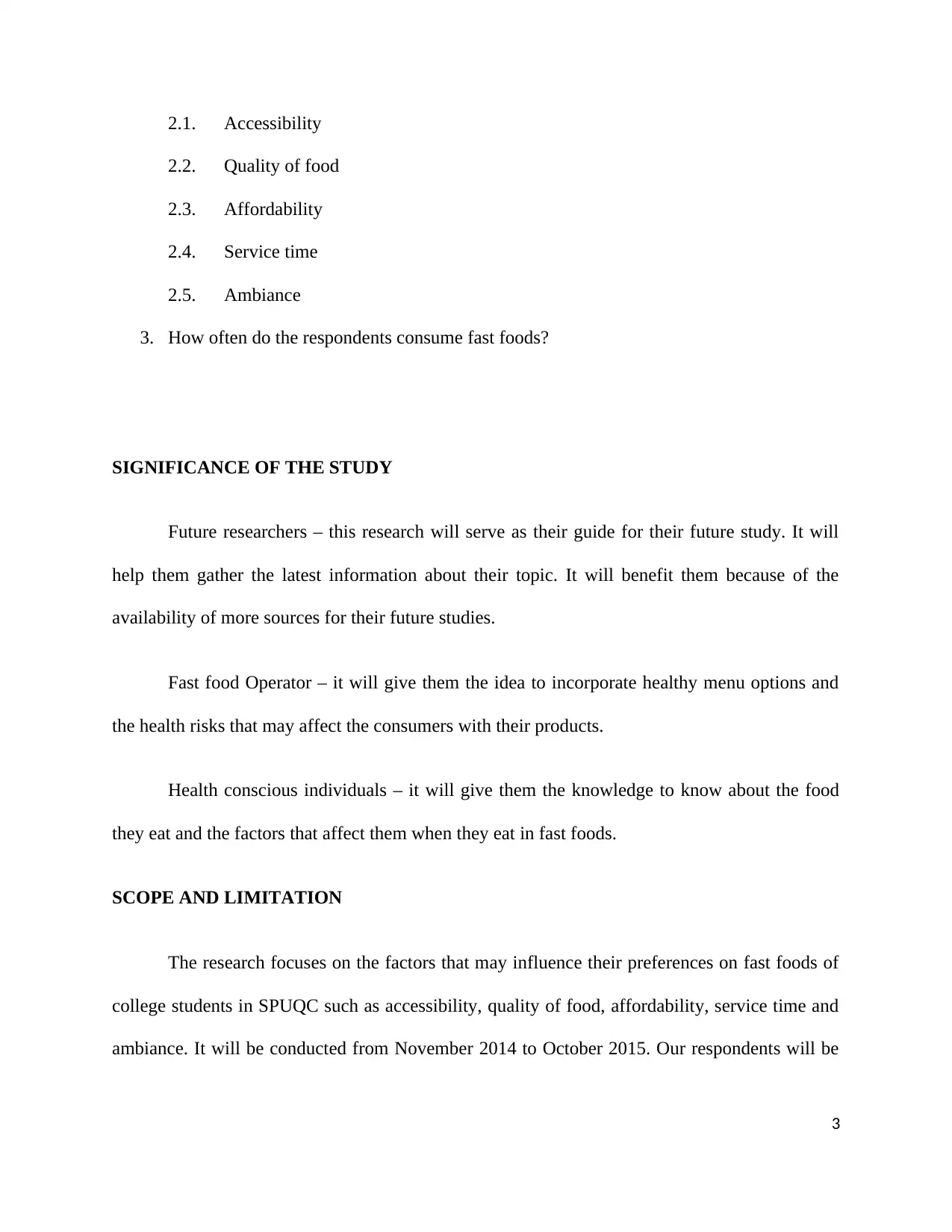
2.1. Accessibility
2.2. Quality of food
2.3. Affordability
2.4. Service time
2.5. Ambiance
3. How often do the respondents consume fast foods?
SIGNIFICANCE OF THE STUDY
Future researchers – this research will serve as their guide for their future study. It will
help them gather the latest information about their topic. It will benefit them because of the
availability of more sources for their future studies.
Fast food Operator – it will give them the idea to incorporate healthy menu options and
the health risks that may affect the consumers with their products.
Health conscious individuals – it will give them the knowledge to know about the food
they eat and the factors that affect them when they eat in fast foods.
SCOPE AND LIMITATION
The research focuses on the factors that may influence their preferences on fast foods of
college students in SPUQC such as accessibility, quality of food, affordability, service time and
ambiance. It will be conducted from November 2014 to October 2015. Our respondents will be
3
2.2. Quality of food
2.3. Affordability
2.4. Service time
2.5. Ambiance
3. How often do the respondents consume fast foods?
SIGNIFICANCE OF THE STUDY
Future researchers – this research will serve as their guide for their future study. It will
help them gather the latest information about their topic. It will benefit them because of the
availability of more sources for their future studies.
Fast food Operator – it will give them the idea to incorporate healthy menu options and
the health risks that may affect the consumers with their products.
Health conscious individuals – it will give them the knowledge to know about the food
they eat and the factors that affect them when they eat in fast foods.
SCOPE AND LIMITATION
The research focuses on the factors that may influence their preferences on fast foods of
college students in SPUQC such as accessibility, quality of food, affordability, service time and
ambiance. It will be conducted from November 2014 to October 2015. Our respondents will be
3
⊘ This is a preview!⊘
Do you want full access?
Subscribe today to unlock all pages.

Trusted by 1+ million students worldwide
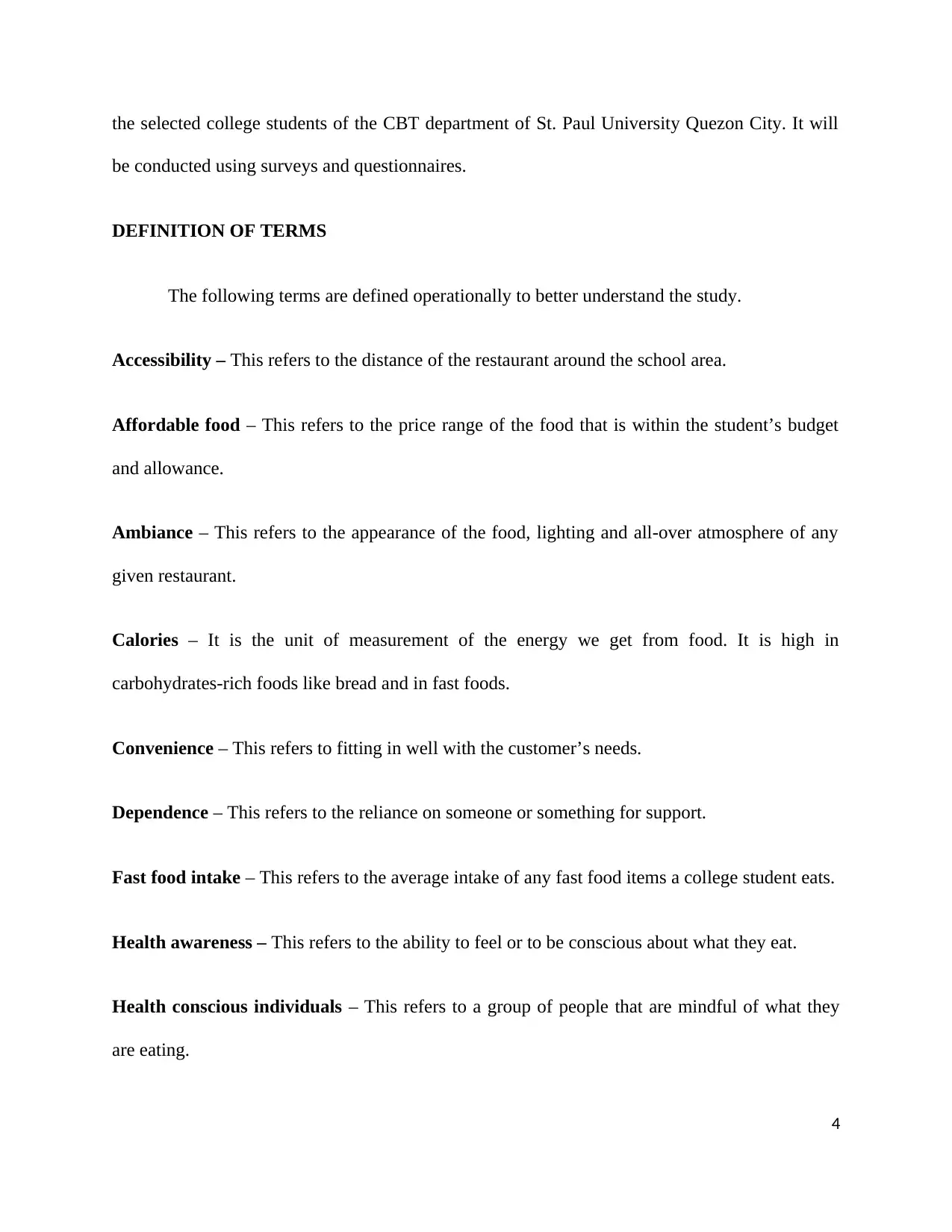
the selected college students of the CBT department of St. Paul University Quezon City. It will
be conducted using surveys and questionnaires.
DEFINITION OF TERMS
The following terms are defined operationally to better understand the study.
Accessibility – This refers to the distance of the restaurant around the school area.
Affordable food – This refers to the price range of the food that is within the student’s budget
and allowance.
Ambiance – This refers to the appearance of the food, lighting and all-over atmosphere of any
given restaurant.
Calories – It is the unit of measurement of the energy we get from food. It is high in
carbohydrates-rich foods like bread and in fast foods.
Convenience – This refers to fitting in well with the customer’s needs.
Dependence – This refers to the reliance on someone or something for support.
Fast food intake – This refers to the average intake of any fast food items a college student eats.
Health awareness – This refers to the ability to feel or to be conscious about what they eat.
Health conscious individuals – This refers to a group of people that are mindful of what they
are eating.
4
be conducted using surveys and questionnaires.
DEFINITION OF TERMS
The following terms are defined operationally to better understand the study.
Accessibility – This refers to the distance of the restaurant around the school area.
Affordable food – This refers to the price range of the food that is within the student’s budget
and allowance.
Ambiance – This refers to the appearance of the food, lighting and all-over atmosphere of any
given restaurant.
Calories – It is the unit of measurement of the energy we get from food. It is high in
carbohydrates-rich foods like bread and in fast foods.
Convenience – This refers to fitting in well with the customer’s needs.
Dependence – This refers to the reliance on someone or something for support.
Fast food intake – This refers to the average intake of any fast food items a college student eats.
Health awareness – This refers to the ability to feel or to be conscious about what they eat.
Health conscious individuals – This refers to a group of people that are mindful of what they
are eating.
4
Paraphrase This Document
Need a fresh take? Get an instant paraphrase of this document with our AI Paraphraser
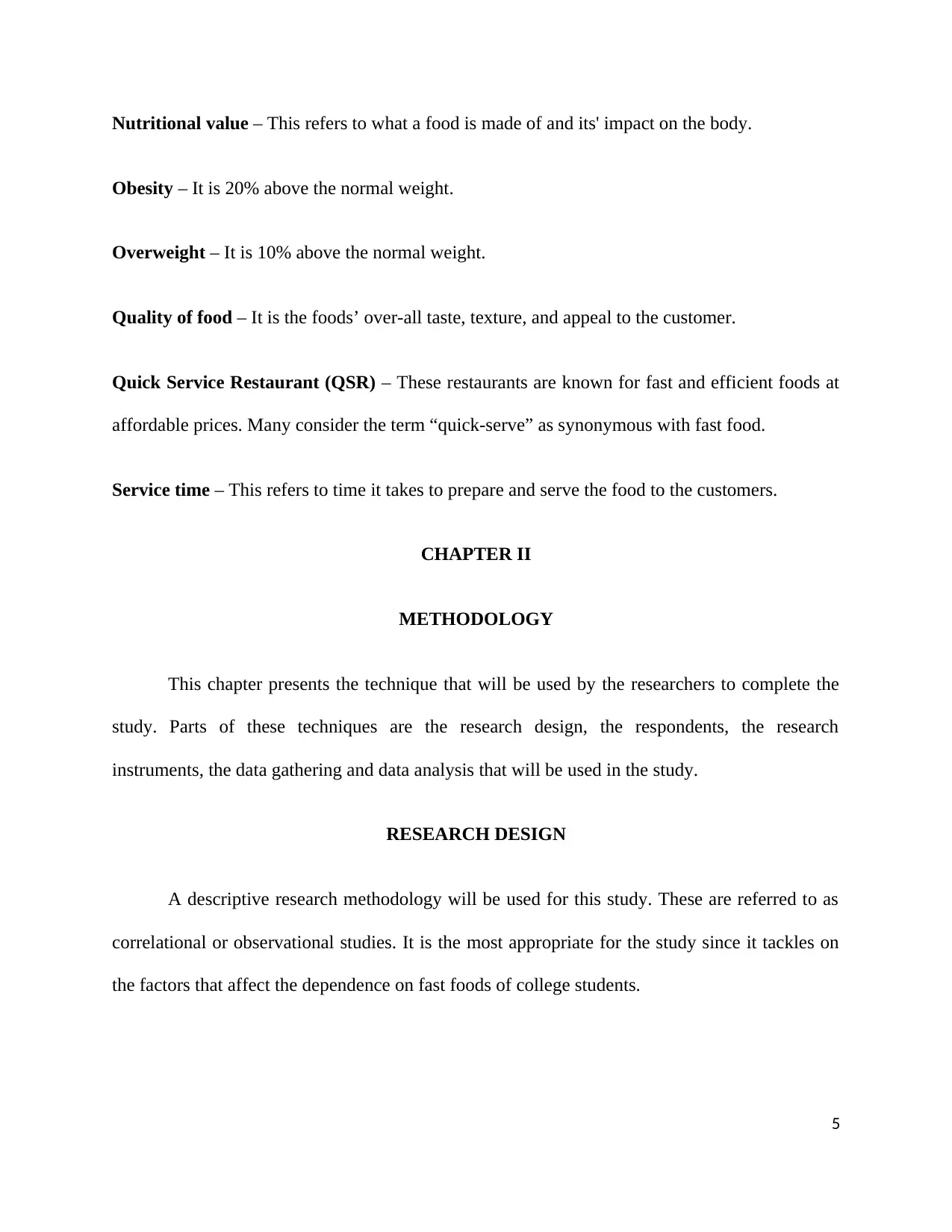
Nutritional value – This refers to what a food is made of and its' impact on the body.
Obesity – It is 20% above the normal weight.
Overweight – It is 10% above the normal weight.
Quality of food – It is the foods’ over-all taste, texture, and appeal to the customer.
Quick Service Restaurant (QSR) – These restaurants are known for fast and efficient foods at
affordable prices. Many consider the term “quick-serve” as synonymous with fast food.
Service time – This refers to time it takes to prepare and serve the food to the customers.
CHAPTER II
METHODOLOGY
This chapter presents the technique that will be used by the researchers to complete the
study. Parts of these techniques are the research design, the respondents, the research
instruments, the data gathering and data analysis that will be used in the study.
RESEARCH DESIGN
A descriptive research methodology will be used for this study. These are referred to as
correlational or observational studies. It is the most appropriate for the study since it tackles on
the factors that affect the dependence on fast foods of college students.
5
Obesity – It is 20% above the normal weight.
Overweight – It is 10% above the normal weight.
Quality of food – It is the foods’ over-all taste, texture, and appeal to the customer.
Quick Service Restaurant (QSR) – These restaurants are known for fast and efficient foods at
affordable prices. Many consider the term “quick-serve” as synonymous with fast food.
Service time – This refers to time it takes to prepare and serve the food to the customers.
CHAPTER II
METHODOLOGY
This chapter presents the technique that will be used by the researchers to complete the
study. Parts of these techniques are the research design, the respondents, the research
instruments, the data gathering and data analysis that will be used in the study.
RESEARCH DESIGN
A descriptive research methodology will be used for this study. These are referred to as
correlational or observational studies. It is the most appropriate for the study since it tackles on
the factors that affect the dependence on fast foods of college students.
5
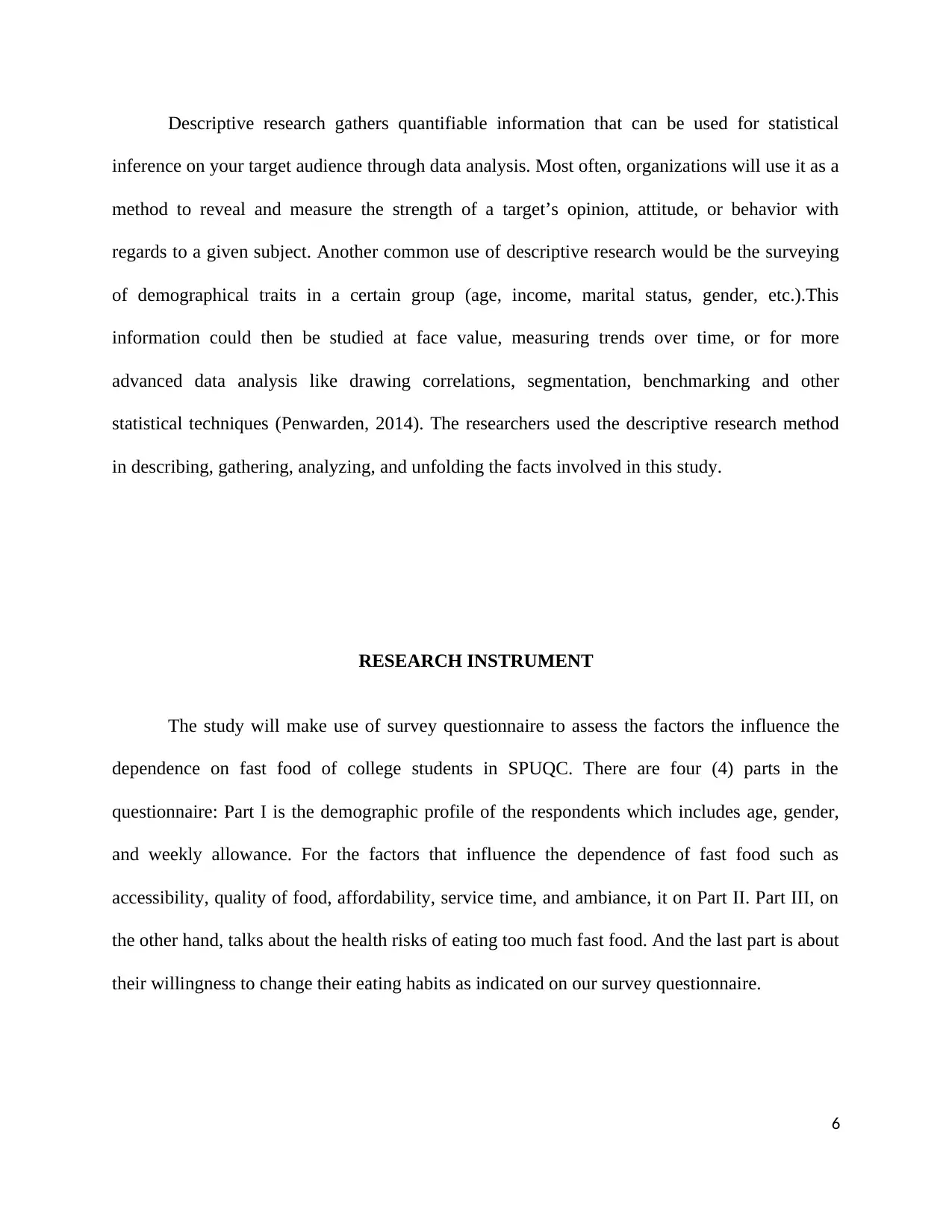
Descriptive research gathers quantifiable information that can be used for statistical
inference on your target audience through data analysis. Most often, organizations will use it as a
method to reveal and measure the strength of a target’s opinion, attitude, or behavior with
regards to a given subject. Another common use of descriptive research would be the surveying
of demographical traits in a certain group (age, income, marital status, gender, etc.).This
information could then be studied at face value, measuring trends over time, or for more
advanced data analysis like drawing correlations, segmentation, benchmarking and other
statistical techniques (Penwarden, 2014). The researchers used the descriptive research method
in describing, gathering, analyzing, and unfolding the facts involved in this study.
RESEARCH INSTRUMENT
The study will make use of survey questionnaire to assess the factors the influence the
dependence on fast food of college students in SPUQC. There are four (4) parts in the
questionnaire: Part I is the demographic profile of the respondents which includes age, gender,
and weekly allowance. For the factors that influence the dependence of fast food such as
accessibility, quality of food, affordability, service time, and ambiance, it on Part II. Part III, on
the other hand, talks about the health risks of eating too much fast food. And the last part is about
their willingness to change their eating habits as indicated on our survey questionnaire.
6
inference on your target audience through data analysis. Most often, organizations will use it as a
method to reveal and measure the strength of a target’s opinion, attitude, or behavior with
regards to a given subject. Another common use of descriptive research would be the surveying
of demographical traits in a certain group (age, income, marital status, gender, etc.).This
information could then be studied at face value, measuring trends over time, or for more
advanced data analysis like drawing correlations, segmentation, benchmarking and other
statistical techniques (Penwarden, 2014). The researchers used the descriptive research method
in describing, gathering, analyzing, and unfolding the facts involved in this study.
RESEARCH INSTRUMENT
The study will make use of survey questionnaire to assess the factors the influence the
dependence on fast food of college students in SPUQC. There are four (4) parts in the
questionnaire: Part I is the demographic profile of the respondents which includes age, gender,
and weekly allowance. For the factors that influence the dependence of fast food such as
accessibility, quality of food, affordability, service time, and ambiance, it on Part II. Part III, on
the other hand, talks about the health risks of eating too much fast food. And the last part is about
their willingness to change their eating habits as indicated on our survey questionnaire.
6
⊘ This is a preview!⊘
Do you want full access?
Subscribe today to unlock all pages.

Trusted by 1+ million students worldwide
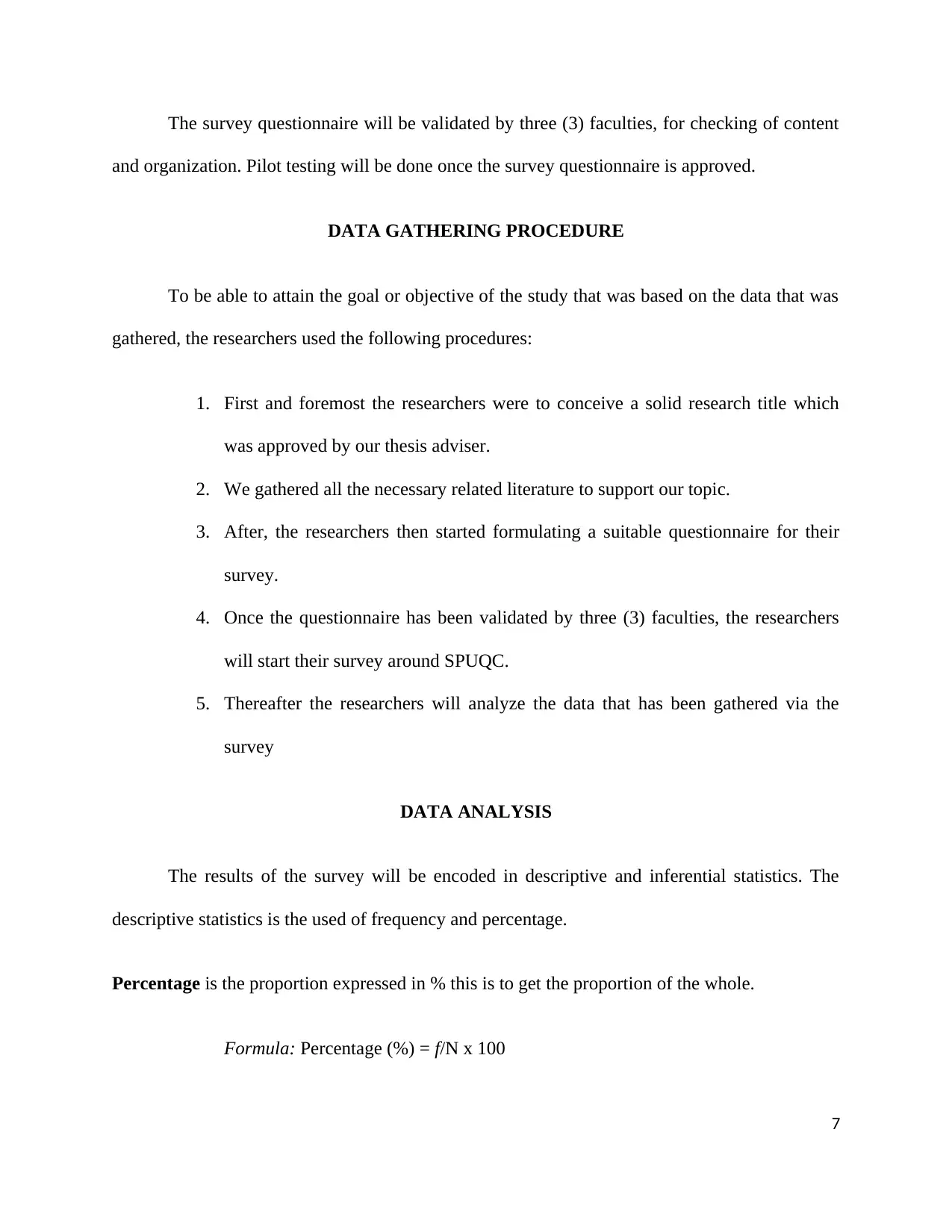
The survey questionnaire will be validated by three (3) faculties, for checking of content
and organization. Pilot testing will be done once the survey questionnaire is approved.
DATA GATHERING PROCEDURE
To be able to attain the goal or objective of the study that was based on the data that was
gathered, the researchers used the following procedures:
1. First and foremost the researchers were to conceive a solid research title which
was approved by our thesis adviser.
2. We gathered all the necessary related literature to support our topic.
3. After, the researchers then started formulating a suitable questionnaire for their
survey.
4. Once the questionnaire has been validated by three (3) faculties, the researchers
will start their survey around SPUQC.
5. Thereafter the researchers will analyze the data that has been gathered via the
survey
DATA ANALYSIS
The results of the survey will be encoded in descriptive and inferential statistics. The
descriptive statistics is the used of frequency and percentage.
Percentage is the proportion expressed in % this is to get the proportion of the whole.
Formula: Percentage (%) = f/N x 100
7
and organization. Pilot testing will be done once the survey questionnaire is approved.
DATA GATHERING PROCEDURE
To be able to attain the goal or objective of the study that was based on the data that was
gathered, the researchers used the following procedures:
1. First and foremost the researchers were to conceive a solid research title which
was approved by our thesis adviser.
2. We gathered all the necessary related literature to support our topic.
3. After, the researchers then started formulating a suitable questionnaire for their
survey.
4. Once the questionnaire has been validated by three (3) faculties, the researchers
will start their survey around SPUQC.
5. Thereafter the researchers will analyze the data that has been gathered via the
survey
DATA ANALYSIS
The results of the survey will be encoded in descriptive and inferential statistics. The
descriptive statistics is the used of frequency and percentage.
Percentage is the proportion expressed in % this is to get the proportion of the whole.
Formula: Percentage (%) = f/N x 100
7
Paraphrase This Document
Need a fresh take? Get an instant paraphrase of this document with our AI Paraphraser
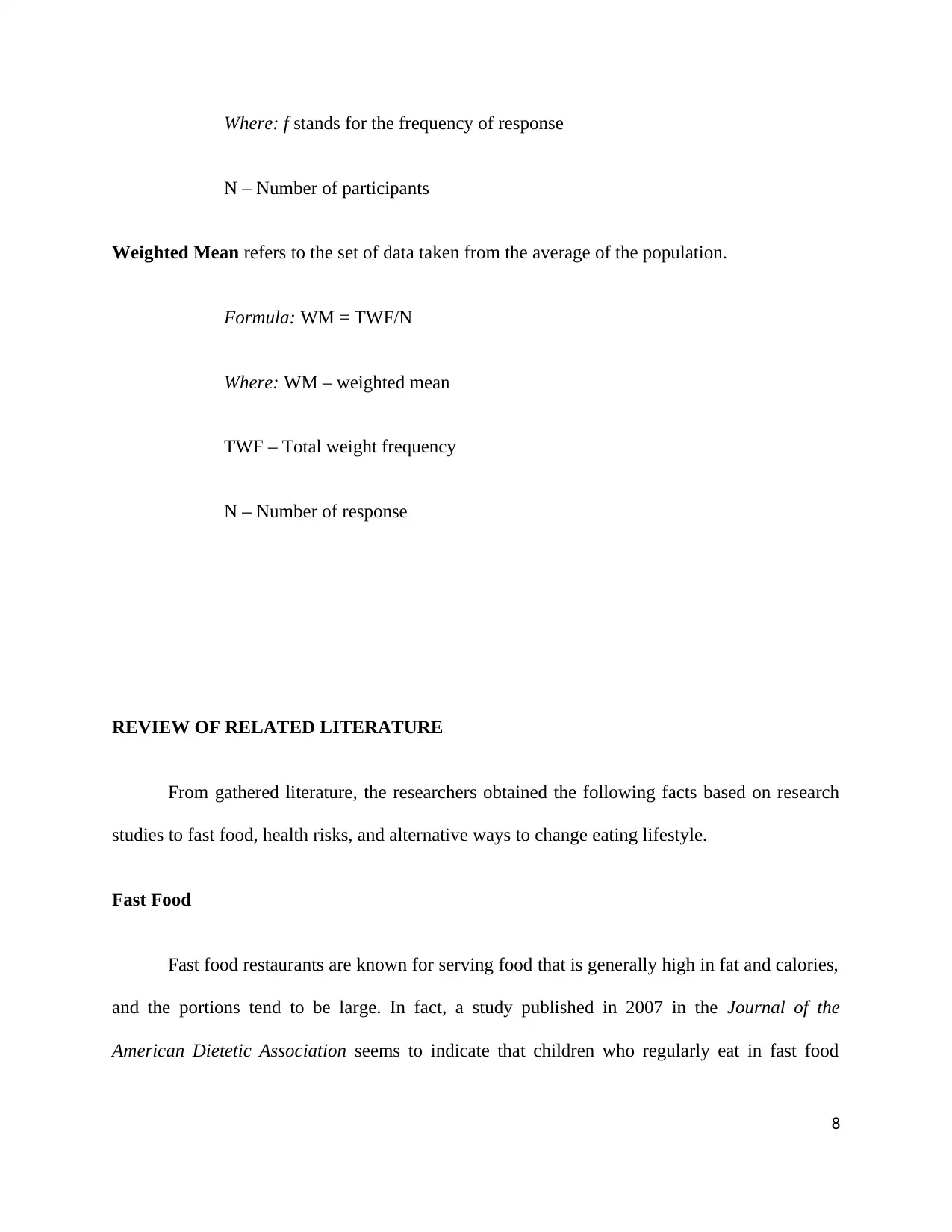
Where: f stands for the frequency of response
N – Number of participants
Weighted Mean refers to the set of data taken from the average of the population.
Formula: WM = TWF/N
Where: WM – weighted mean
TWF – Total weight frequency
N – Number of response
REVIEW OF RELATED LITERATURE
From gathered literature, the researchers obtained the following facts based on research
studies to fast food, health risks, and alternative ways to change eating lifestyle.
Fast Food
Fast food restaurants are known for serving food that is generally high in fat and calories,
and the portions tend to be large. In fact, a study published in 2007 in the Journal of the
American Dietetic Association seems to indicate that children who regularly eat in fast food
8
N – Number of participants
Weighted Mean refers to the set of data taken from the average of the population.
Formula: WM = TWF/N
Where: WM – weighted mean
TWF – Total weight frequency
N – Number of response
REVIEW OF RELATED LITERATURE
From gathered literature, the researchers obtained the following facts based on research
studies to fast food, health risks, and alternative ways to change eating lifestyle.
Fast Food
Fast food restaurants are known for serving food that is generally high in fat and calories,
and the portions tend to be large. In fact, a study published in 2007 in the Journal of the
American Dietetic Association seems to indicate that children who regularly eat in fast food
8
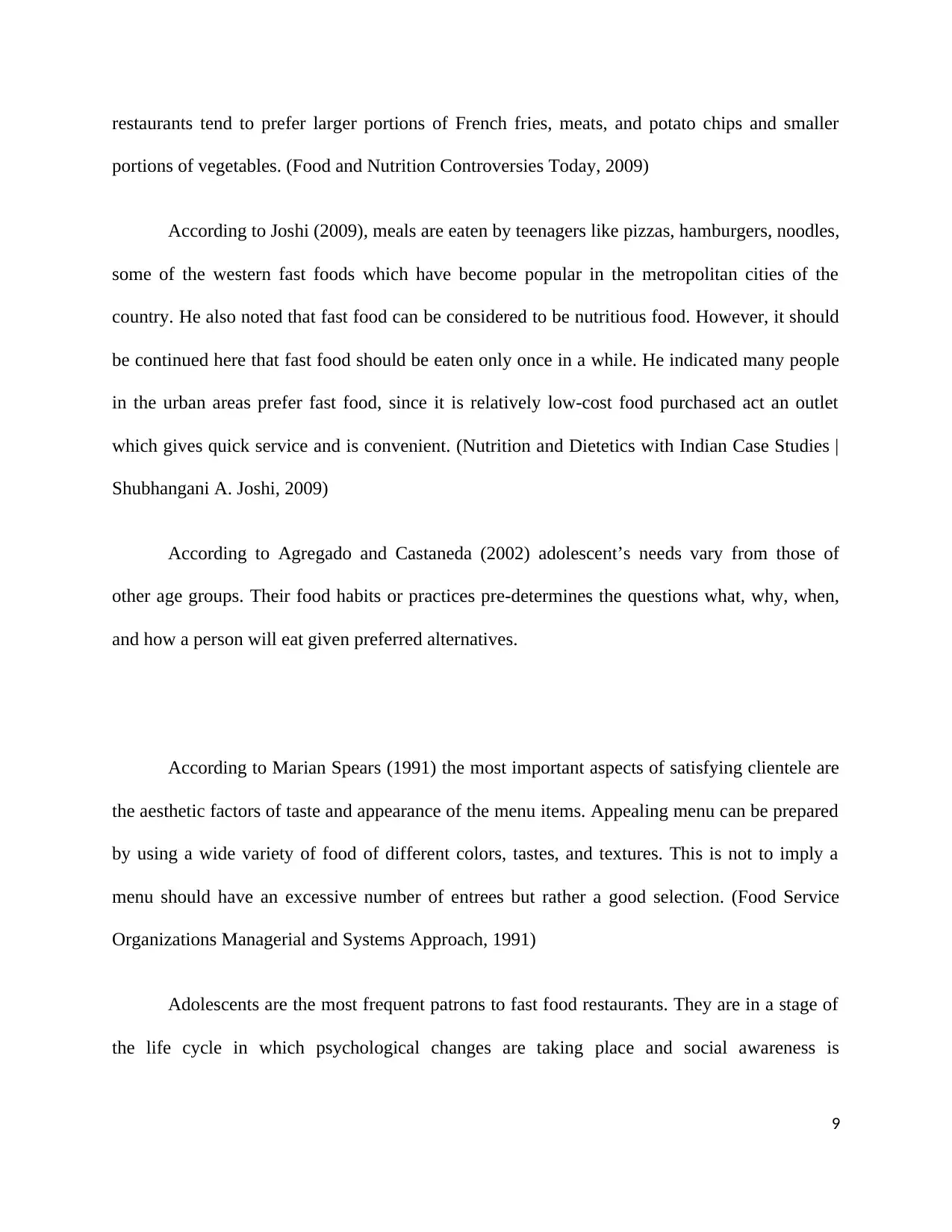
restaurants tend to prefer larger portions of French fries, meats, and potato chips and smaller
portions of vegetables. (Food and Nutrition Controversies Today, 2009)
According to Joshi (2009), meals are eaten by teenagers like pizzas, hamburgers, noodles,
some of the western fast foods which have become popular in the metropolitan cities of the
country. He also noted that fast food can be considered to be nutritious food. However, it should
be continued here that fast food should be eaten only once in a while. He indicated many people
in the urban areas prefer fast food, since it is relatively low-cost food purchased act an outlet
which gives quick service and is convenient. (Nutrition and Dietetics with Indian Case Studies |
Shubhangani A. Joshi, 2009)
According to Agregado and Castaneda (2002) adolescent’s needs vary from those of
other age groups. Their food habits or practices pre-determines the questions what, why, when,
and how a person will eat given preferred alternatives.
According to Marian Spears (1991) the most important aspects of satisfying clientele are
the aesthetic factors of taste and appearance of the menu items. Appealing menu can be prepared
by using a wide variety of food of different colors, tastes, and textures. This is not to imply a
menu should have an excessive number of entrees but rather a good selection. (Food Service
Organizations Managerial and Systems Approach, 1991)
Adolescents are the most frequent patrons to fast food restaurants. They are in a stage of
the life cycle in which psychological changes are taking place and social awareness is
9
portions of vegetables. (Food and Nutrition Controversies Today, 2009)
According to Joshi (2009), meals are eaten by teenagers like pizzas, hamburgers, noodles,
some of the western fast foods which have become popular in the metropolitan cities of the
country. He also noted that fast food can be considered to be nutritious food. However, it should
be continued here that fast food should be eaten only once in a while. He indicated many people
in the urban areas prefer fast food, since it is relatively low-cost food purchased act an outlet
which gives quick service and is convenient. (Nutrition and Dietetics with Indian Case Studies |
Shubhangani A. Joshi, 2009)
According to Agregado and Castaneda (2002) adolescent’s needs vary from those of
other age groups. Their food habits or practices pre-determines the questions what, why, when,
and how a person will eat given preferred alternatives.
According to Marian Spears (1991) the most important aspects of satisfying clientele are
the aesthetic factors of taste and appearance of the menu items. Appealing menu can be prepared
by using a wide variety of food of different colors, tastes, and textures. This is not to imply a
menu should have an excessive number of entrees but rather a good selection. (Food Service
Organizations Managerial and Systems Approach, 1991)
Adolescents are the most frequent patrons to fast food restaurants. They are in a stage of
the life cycle in which psychological changes are taking place and social awareness is
9
⊘ This is a preview!⊘
Do you want full access?
Subscribe today to unlock all pages.

Trusted by 1+ million students worldwide
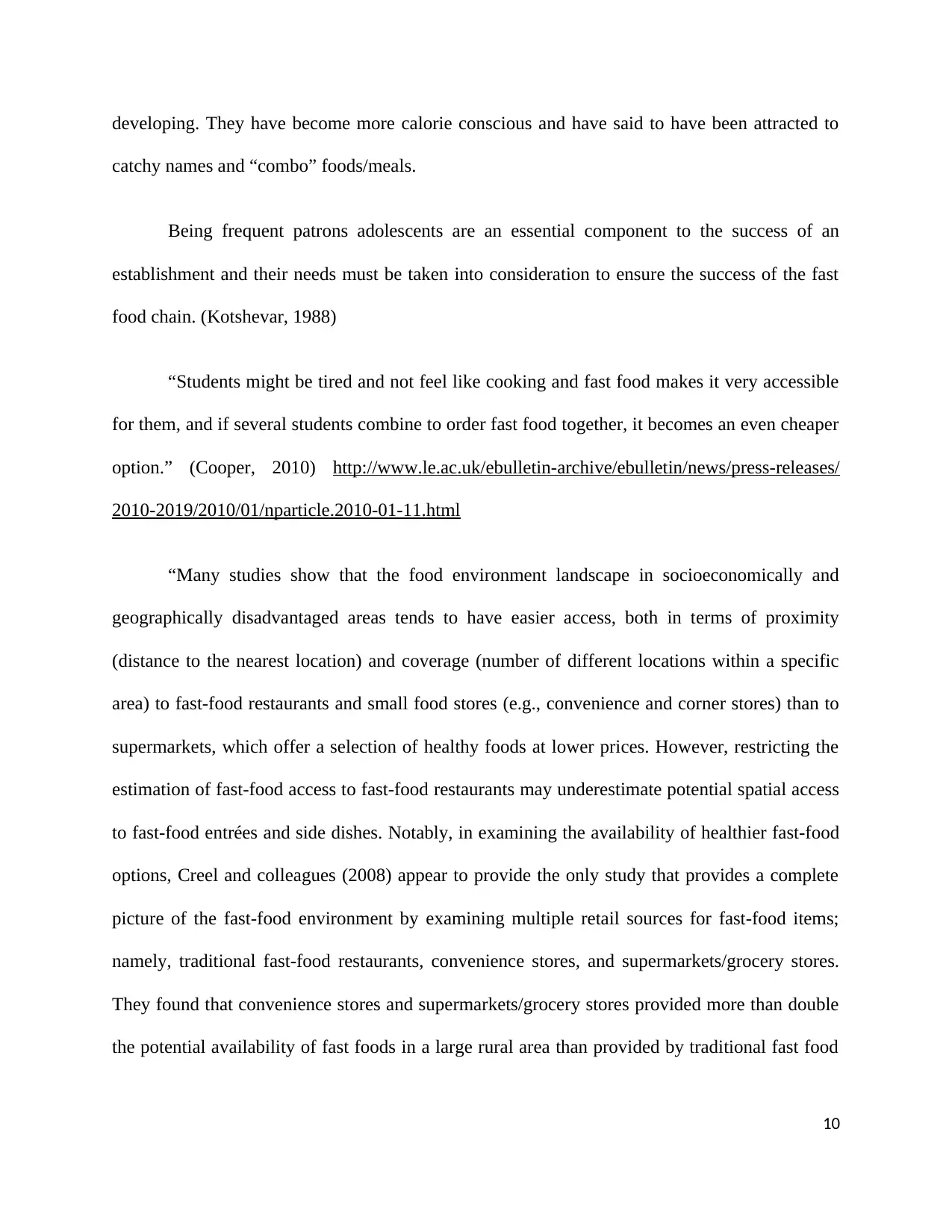
developing. They have become more calorie conscious and have said to have been attracted to
catchy names and “combo” foods/meals.
Being frequent patrons adolescents are an essential component to the success of an
establishment and their needs must be taken into consideration to ensure the success of the fast
food chain. (Kotshevar, 1988)
“Students might be tired and not feel like cooking and fast food makes it very accessible
for them, and if several students combine to order fast food together, it becomes an even cheaper
option.” (Cooper, 2010) http://www.le.ac.uk/ebulletin-archive/ebulletin/news/press-releases/
2010-2019/2010/01/nparticle.2010-01-11.html
“Many studies show that the food environment landscape in socioeconomically and
geographically disadvantaged areas tends to have easier access, both in terms of proximity
(distance to the nearest location) and coverage (number of different locations within a specific
area) to fast-food restaurants and small food stores (e.g., convenience and corner stores) than to
supermarkets, which offer a selection of healthy foods at lower prices. However, restricting the
estimation of fast-food access to fast-food restaurants may underestimate potential spatial access
to fast-food entrées and side dishes. Notably, in examining the availability of healthier fast-food
options, Creel and colleagues (2008) appear to provide the only study that provides a complete
picture of the fast-food environment by examining multiple retail sources for fast-food items;
namely, traditional fast-food restaurants, convenience stores, and supermarkets/grocery stores.
They found that convenience stores and supermarkets/grocery stores provided more than double
the potential availability of fast foods in a large rural area than provided by traditional fast food
10
catchy names and “combo” foods/meals.
Being frequent patrons adolescents are an essential component to the success of an
establishment and their needs must be taken into consideration to ensure the success of the fast
food chain. (Kotshevar, 1988)
“Students might be tired and not feel like cooking and fast food makes it very accessible
for them, and if several students combine to order fast food together, it becomes an even cheaper
option.” (Cooper, 2010) http://www.le.ac.uk/ebulletin-archive/ebulletin/news/press-releases/
2010-2019/2010/01/nparticle.2010-01-11.html
“Many studies show that the food environment landscape in socioeconomically and
geographically disadvantaged areas tends to have easier access, both in terms of proximity
(distance to the nearest location) and coverage (number of different locations within a specific
area) to fast-food restaurants and small food stores (e.g., convenience and corner stores) than to
supermarkets, which offer a selection of healthy foods at lower prices. However, restricting the
estimation of fast-food access to fast-food restaurants may underestimate potential spatial access
to fast-food entrées and side dishes. Notably, in examining the availability of healthier fast-food
options, Creel and colleagues (2008) appear to provide the only study that provides a complete
picture of the fast-food environment by examining multiple retail sources for fast-food items;
namely, traditional fast-food restaurants, convenience stores, and supermarkets/grocery stores.
They found that convenience stores and supermarkets/grocery stores provided more than double
the potential availability of fast foods in a large rural area than provided by traditional fast food
10
Paraphrase This Document
Need a fresh take? Get an instant paraphrase of this document with our AI Paraphraser

restaurants alone.” http://search.proquest.com/docview/902242462/884B31EBE5014342PQ/13?
accountid=33657
“Younger adults have a high consumption of fast food. Individuals aged 19 to 20 years
consumed fewer calories from home and more calories from fast foods as com- pared to
adolescents 12 to 18 years of age. Adults between 20 to 29 years of age had significantly greater
consumption of fast food, approximately four times greater, as compared to those aged 55 years
and older. College students aged 19 to 25 years have reported that the top reasons reported
for fast food consumption were convenience and cost (convenience being to top reason). A
similar study concluded that college students aged 19 to 24 years were consuming fast food for
convenience (which was in the top two reasons for consuming fast food) and males were likely
to choose fast food due to the cost. Males tend to consume more fast food items per week than
females.” http://search.proquest.com/docview/1034971788/10EE552EDF6646A1PQ/1?
accountid=33657
“College students like their fast food restaurants to be above all else clean, friendly, and
inexpensive-yet no chain is positioning itself to be the cleanest or friendliest. It is no secret that
college life and fast food go together. Fast food restaurants are often conveniently located on or
near campuses. They are found in student centers, food courts in student unions, and tucked into
other university buildings. When it comes to fast food, some researchers have found that the
attributes that matter most are: low price, speed of service, consistency, and convenient location.
For adults under age 25, price is the most important determinant for fast food choices.”
http://search.proquest.com/docview/209704834/884B31EBE5014342PQ/79?accountid=33657
11
accountid=33657
“Younger adults have a high consumption of fast food. Individuals aged 19 to 20 years
consumed fewer calories from home and more calories from fast foods as com- pared to
adolescents 12 to 18 years of age. Adults between 20 to 29 years of age had significantly greater
consumption of fast food, approximately four times greater, as compared to those aged 55 years
and older. College students aged 19 to 25 years have reported that the top reasons reported
for fast food consumption were convenience and cost (convenience being to top reason). A
similar study concluded that college students aged 19 to 24 years were consuming fast food for
convenience (which was in the top two reasons for consuming fast food) and males were likely
to choose fast food due to the cost. Males tend to consume more fast food items per week than
females.” http://search.proquest.com/docview/1034971788/10EE552EDF6646A1PQ/1?
accountid=33657
“College students like their fast food restaurants to be above all else clean, friendly, and
inexpensive-yet no chain is positioning itself to be the cleanest or friendliest. It is no secret that
college life and fast food go together. Fast food restaurants are often conveniently located on or
near campuses. They are found in student centers, food courts in student unions, and tucked into
other university buildings. When it comes to fast food, some researchers have found that the
attributes that matter most are: low price, speed of service, consistency, and convenient location.
For adults under age 25, price is the most important determinant for fast food choices.”
http://search.proquest.com/docview/209704834/884B31EBE5014342PQ/79?accountid=33657
11
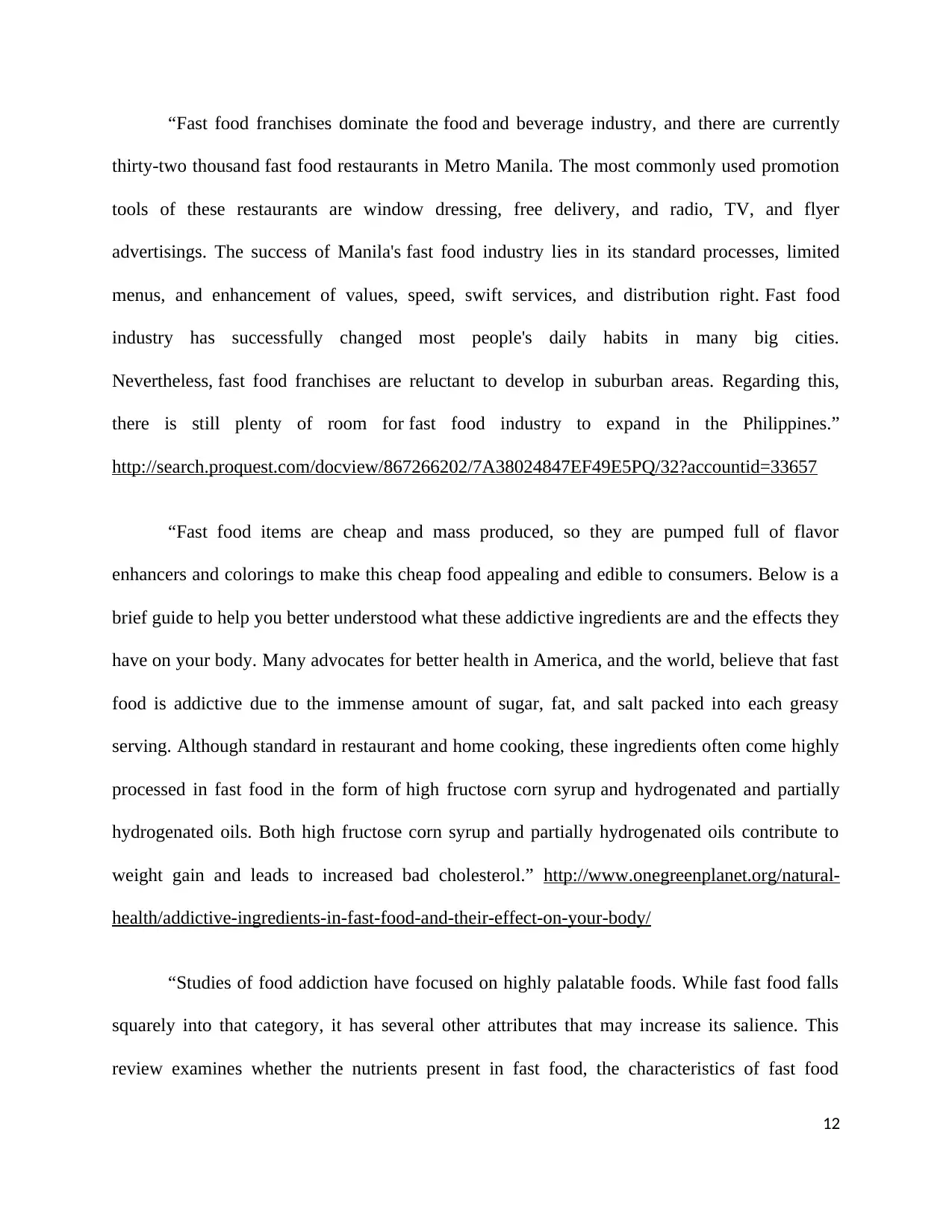
“Fast food franchises dominate the food and beverage industry, and there are currently
thirty-two thousand fast food restaurants in Metro Manila. The most commonly used promotion
tools of these restaurants are window dressing, free delivery, and radio, TV, and flyer
advertisings. The success of Manila's fast food industry lies in its standard processes, limited
menus, and enhancement of values, speed, swift services, and distribution right. Fast food
industry has successfully changed most people's daily habits in many big cities.
Nevertheless, fast food franchises are reluctant to develop in suburban areas. Regarding this,
there is still plenty of room for fast food industry to expand in the Philippines.”
http://search.proquest.com/docview/867266202/7A38024847EF49E5PQ/32?accountid=33657
“Fast food items are cheap and mass produced, so they are pumped full of flavor
enhancers and colorings to make this cheap food appealing and edible to consumers. Below is a
brief guide to help you better understood what these addictive ingredients are and the effects they
have on your body. Many advocates for better health in America, and the world, believe that fast
food is addictive due to the immense amount of sugar, fat, and salt packed into each greasy
serving. Although standard in restaurant and home cooking, these ingredients often come highly
processed in fast food in the form of high fructose corn syrup and hydrogenated and partially
hydrogenated oils. Both high fructose corn syrup and partially hydrogenated oils contribute to
weight gain and leads to increased bad cholesterol.” http://www.onegreenplanet.org/natural-
health/addictive-ingredients-in-fast-food-and-their-effect-on-your-body/
“Studies of food addiction have focused on highly palatable foods. While fast food falls
squarely into that category, it has several other attributes that may increase its salience. This
review examines whether the nutrients present in fast food, the characteristics of fast food
12
thirty-two thousand fast food restaurants in Metro Manila. The most commonly used promotion
tools of these restaurants are window dressing, free delivery, and radio, TV, and flyer
advertisings. The success of Manila's fast food industry lies in its standard processes, limited
menus, and enhancement of values, speed, swift services, and distribution right. Fast food
industry has successfully changed most people's daily habits in many big cities.
Nevertheless, fast food franchises are reluctant to develop in suburban areas. Regarding this,
there is still plenty of room for fast food industry to expand in the Philippines.”
http://search.proquest.com/docview/867266202/7A38024847EF49E5PQ/32?accountid=33657
“Fast food items are cheap and mass produced, so they are pumped full of flavor
enhancers and colorings to make this cheap food appealing and edible to consumers. Below is a
brief guide to help you better understood what these addictive ingredients are and the effects they
have on your body. Many advocates for better health in America, and the world, believe that fast
food is addictive due to the immense amount of sugar, fat, and salt packed into each greasy
serving. Although standard in restaurant and home cooking, these ingredients often come highly
processed in fast food in the form of high fructose corn syrup and hydrogenated and partially
hydrogenated oils. Both high fructose corn syrup and partially hydrogenated oils contribute to
weight gain and leads to increased bad cholesterol.” http://www.onegreenplanet.org/natural-
health/addictive-ingredients-in-fast-food-and-their-effect-on-your-body/
“Studies of food addiction have focused on highly palatable foods. While fast food falls
squarely into that category, it has several other attributes that may increase its salience. This
review examines whether the nutrients present in fast food, the characteristics of fast food
12
⊘ This is a preview!⊘
Do you want full access?
Subscribe today to unlock all pages.

Trusted by 1+ million students worldwide
1 out of 21
Your All-in-One AI-Powered Toolkit for Academic Success.
+13062052269
info@desklib.com
Available 24*7 on WhatsApp / Email
![[object Object]](/_next/static/media/star-bottom.7253800d.svg)
Unlock your academic potential
Copyright © 2020–2025 A2Z Services. All Rights Reserved. Developed and managed by ZUCOL.
